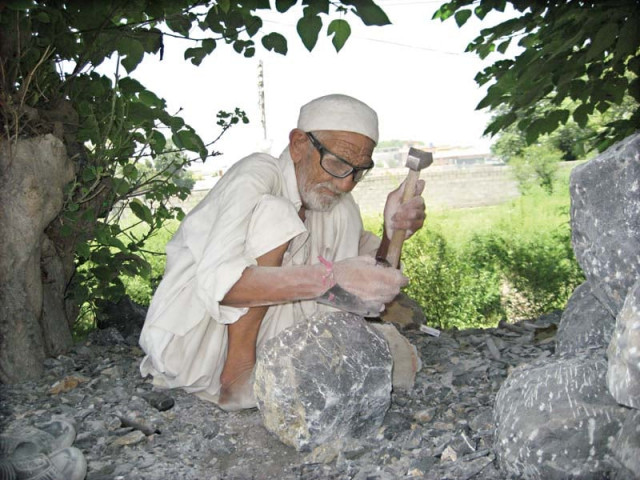Pride in their work: Carving a future by chiseling history
Skill lives on as it is passed from parents to the next generation

Stone replicas carved and made in Panj Katha. PHOTOS: EXPRESS
The sites of the ancient Buddhist cities of Pind Gakhra, Jandial, Nikra Bangal in Haripur and adjoining areas of Taxila are famous for housing a number of archaeological structures of international fame, including the Julian University from 3 BCE.

The ancient seat of learning is listed in UNESCO’s list of World Heritage Sites. Those structures may have been carved out thousands of years ago, but even today’s sculptors take great pride in making replicas of the works of their forefathers.
“The sculptors of Panj Katha and Taxila are so skilled in the art, they can carve replicas of Gandhara art in such a way that one can hardly tell the difference,” says Gulab Khan, an octogenarian artistan, hailing from Panj Katha.
“The real specialty of this area are langris (mortar and pestle) created with black hard stone,” he tells The Express Tribune, while taking a break from a long day of carving. Black stone is also chiseled into gravestones, flower pots and other decoration pieces and many people especially come looking for it.
Gulab’s family has been in this business for over three centuries. Doing his bit, he has passed the expertise on to the next two generations of his family. Not just that, he has had over 50 apprentices.
Even though it does not earn him a lot of money, Gulab still adores his work. He can create at least four mortars from scratch on a good day, earning just Rs75 per piece.

The maestro is content with his share of the modest earnings. “Since we have no other skill to use, we have to accept whatever comes our way,” he says.
“The art of carving black stone into mortars was introduced during the second century in the Bhir Mound-era, a century before the Greeks came here,” says Dr Shakirullah, a teacher at the archaeology department of the Hazara University.
He also explained artisans of Panj Katha area of Khanpur and neighbouring Taxila city inherited this art from their forefathers and actively passed it on to their next generations. He believes it is a great service on their part to keep the art alive. However, it is sad that these skilled artisans are not aware of precautionary measures they should take while chiseling stone. Flying splinters often cause injuries and the dust inhaled during the process does permanent damage to their lungs.
Published in The Express Tribune, August 10th, 2016.













COMMENTS
Comments are moderated and generally will be posted if they are on-topic and not abusive.
For more information, please see our Comments FAQ